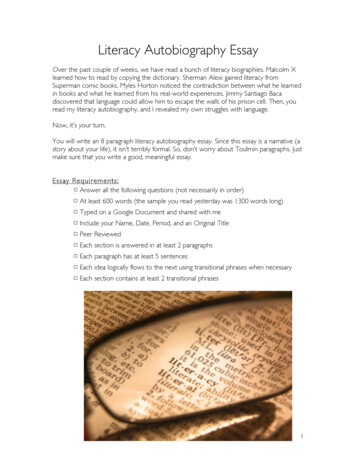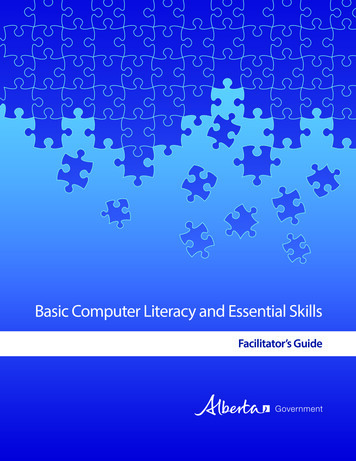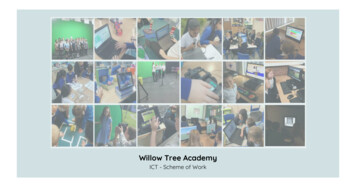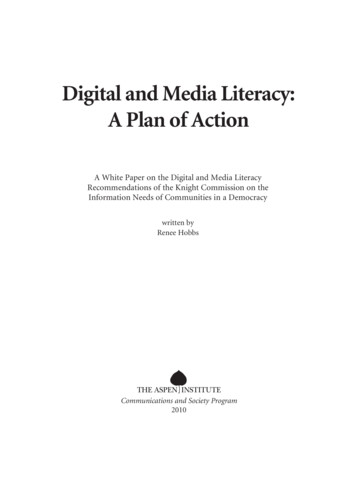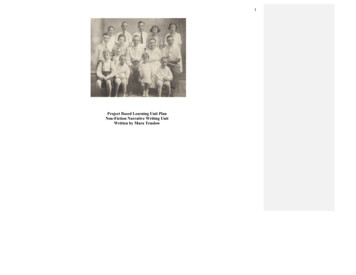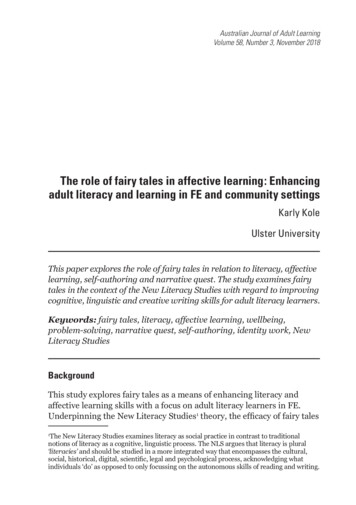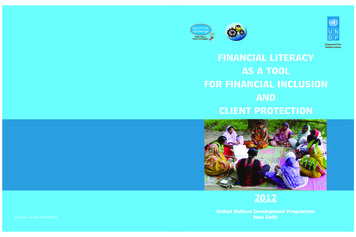
Transcription
FINANCIAL LITERACYAS A TOOLFOR FINANCIAL INCLUSIONANDCLIENT PROTECTION
Peer Review and SupportPrema GeraAssistant Country Director & Head,Poverty Unit, UNDP IndiaRatneshProgramme AnalystUNDP IndiaConceptualization andStructure of ReportNavin AnandResource Person and ModeratorMicrofinanceCommunity of PracticeConsolidation and Writing of ReportHEMANTHA KUMAR PAMARTHYSpecial Thanks and AcknowledgementsSincere acknowledgements are due to the authors and institutions who have undertaken studiesand to all those Microfinance enthusiasts, specialists and experts who have participated in the twoe-discussions initiated by the “Microfinance Community, Solution Exchange, United NationsDevelopment Programme (UNDP) India” on whose resources and data this compilation has beenmade possible.Acknowledgements are due to: BASICS Limited, Hyderabad, Andhra Pradesh, IndiaProf. RajanishDass, Indian Institute of Management, Ahmedabad, Gujarat, IndiaMr. Gopala Krishna Ayitam, Agri Biz India, Hyderabad, Andhra Pradesh, IndiaThis work is a product of several studies both commissioned by UNDP on its own and withpartners as also with external references and experiences. The findings, interpretations andconclusions expressed in this work need not necessarily reflect the views of the UNDP, its officersor the governments where the programmes are undertaken.ii
AUTHOR’S NOTEWhenever we think of Financial Inclusion (FI), we should be thinking of those tribes or ethnic minorities in theworld who have not been exposed to the worldly matters and who may not understand the concept of money, letalone finance.Many of the disadvantaged people across the world are like these tribes; with one difference though, in that theyneed money, but may have very limited knowledge of using the money.Literacy and Financial Literacy (FL), thus form the most integral part of the Financial Inclusion as, withoutknowing the fundamentals, the disadvantaged people can continue to be innocent, gullible and in some casesunknowingly irresponsible too. One of the primary objectives of Financial Literacy would be to help thedisadvantaged practice thrift and induce them to save, access credit, use the funds to find a better livelihood, earnincome and thus join the mainstream from exclusion.Many agencies in the world, as also in our country, are working towards this end but there is a need to pause andtake stock whether the intended methods are in the right direction or a midway course correction is required.Mr. Sameer Kochhar of SKOCH Foundation, who has been working relentlessly towards the Financial Inclusion,in his book “Speeding Financial Inclusion” mentioned that Financial Inclusion unfortunately has becomesynonymous with the mere opening of bank accounts and reduced to creating channels for Electronic BenefitTransfer (EBT), where-as it should be much more.UNDP-NABARD undertookin-depth studies in seven focusstates of India and this report is a compilation andsumming up of these reports with additional inputs, wherever needed and possible.My sincere thanks to Ms. Prema Gera, Assistant Country Director & Head, Poverty Unit, UNDP, Mr. Ratnesh,Programme Analyst, UNDP and Dr. Navin Anand, Resource Person andModerator, Microfinance CommunitySolution Exchange of UNDP and other members of UNDP,who reposed confidence in me to compile and writethis report.I earnestly hope that their confidence is not misplaced and that this report would become worthy of their trust tobecome a useful document in the Financial Inclusion of India.Hemantha Kumar Pamarthy15thNovember, 2012iii
PREFACEPREFACEIn the war against poverty, Financial Inclusion (FI) has emerged as a priority for policy makers andIn the war against poverty, Financial Inclusion(FI) has emerged as a priority for policy makers andregulators in over 60 developing countriesa across the globe. An increasing number of countries haveregulators in over 60 developing countriesa across the globe. An increasing number of countries haveintroduced or introducing holistic approaches and methods to improve access to finance.introduced or introducing holistic approaches and methods to improve access to finance.A Financial Inclusion Experts Group (FIEG) was created, to expandaccess to finance for householdA Financial Inclusion Experts Group (FIEG) was created, to expandaccess to finance for householdconsumers and micro, small and medium sized enterprises. The group has developed nine Principles forconsumers and micro, small and medium sized enterprises. The group has developed nine Principles forInnovative Financial Inclusion viz., Leadership, diversity, innovation, protection, empowerment,Innovative Financial Inclusion viz., Leadership, diversity, innovation, protection, empowerment,cooperation, knowledge, proportionality and framework, from experiences and lessons learned fromcooperation, knowledge, proportionality and framework, from experiences and lessons learned frompolicymakers across the world, which have been endorsed during the Toronto Summit in June, 2010.policymakers across the world, which have been endorsed during the Toronto Summit in June, 2010.In India, though the activity of financial inclusion started as early as 1950, from the year 2005 onwardsIn India, though the activity of financial inclusion started as early as 1950, from the year 2005 onwardsfinancial inclusion has been considered a Policy Priority for Reserve Bank of India (RBI), India’s centralfinancial inclusion has been considered a Policy Priority for Reserve Bank of India (RBI), India’s centralbank, which has given several directions and guidelines during the past one decade. It looks at FI as anbank, which has given several directions and guidelines during the past one decade. It looks at FI as aneffective tool for inclusive growth ensuring equality of opportunity for all. RBI has been focusing oneffective tool for inclusive growth ensuring equality of opportunity for all. RBI has been focusing onfacilitating a process of making available a range of appropriate financial products and services to thefacilitating a process of making available a range of appropriate financialproducts and services to theunderprivileged sections of the Indian Society at an affordable costb.underprivileged sections of the Indian Society at an affordable costb.Keeping a credit delivery focus, RBI has given guidelines to banks in the country encouraging financialKeeping a credit delivery focus, RBI has given guidelines to banks in the country encouraging financialinclusion such as implementation through the banks and dis-incentivising those banks which are notinclusion such as implementation through the banks and dis-incentivising those banks which are notresponsive to the community including the underprivileged. Banks have been urged to align theirresponsive to the community including the underprivileged. Banks have been urged to align theirexisting practices with the objectives of financial inclusion.existing practices with the objectives of financial inclusion.From 2006 more enabling environment was being created with opening No-Frill Accounts, OverdraftFrom 2006 more enabling environment was being created with opening No-Frill Accounts, Overdraftfacility for Saving Bank Accounts, Relaxed Know Your Customer (KYC) norms, permitting the banksfacility for Saving Bank Accounts, Relaxed Know Your Customer (KYC) norms, permitting the banksto use the services of intermediaries-Business Correspondents (BC) and Business Facilitators (BF).to use the services of intermediaries-Business Correspondents (BC) and Business Facilitators ---------------------------------aaCGAP publication “Implementing Client Protection Principles” a Technical Guide for Investors by Sarah Forster, EstelleCGAPLahayeand “ImplementingKate McKee, September,2009. Principles” a Technical Guide for Investors by Sarah Forster, Estelle LahayepublicationClient ProtectionbA Presentation“FinancialandKate McKee,titledSeptember,2009.Inclusion, RBI Initiatives” by Dr. K. C. Chakrabarty, Deputy Governor, Reserve Bank ofbIndia,at ‘NationalSeminaron LaunchingNationalInitiativefor K.FinancialInclusion’Deputyat NewGovernor,Delhi onReserve18th September,A tives”by Dr.C. Chakrabarty,Bank ofth2012 DG KCC Presentation2009. Extractedon Seminar11 November,India,at ‘Nationalon Launchinga NationalInitiative for Financial Inclusion’ at New Delhi on 18th September,RBI Initiatives.pdf2009. Extracted on 11th November, 2012 from http://www.nabard.org/departments/pdf/seminar/DG KCC PresentationRBI Initiatives.pdfiv
A working group was constituted to examine the experience of the BCs & BFs, keeping an eye on theregulatory and supervisory frame work and consumer protection issues, Kisan Credit Cards (KCC)/General Credit Cards(GCC) guidelines, Liberal bank branch expansion, allowing Regional Rural Banks(RRBs) and Co-operative Banks to sell Insurance and other financial products also, other than savings,introducing technology products such as pre-paid cards and services such as Mobile Banking. Specialfunds have been facilitated to take care of Financial Literacy Programmes.Despite such positive measures, the financial inclusion in the country still seem to be having a goodscope to take steam in going ahead on expectations.While several impediments and gaps have been identified in reaching the destination of total financialinclusion, financial literacy seems to be a primary requirement to ensure better financial inclusionsupported by credit delivery in innovative methods like Information and Communication Technology(ICT) and Client Protection activities.This report is a compilation of studies, titled “Conducting an Assessment Study of design and deliveryof Financial Literacy among poor across 7 UN Focus States” by BASICS Limited, Hyderabad, AndhraPradesh (AP), India for UNDP; “Facilitating ICT enabled Financial Inclusion in India” by Prof. RajanishDass, Indian Institute of Management, Ahmedabad, Gujarat, India for UNDP-NABARD; with otherinputs from “State Level Financial Literacy Strategies Summary Report for 7 States under UNDPNABARD Financial Inclusion Project” by Mr. Gopala Krishna Ayitam, Agri Biz India, Hyderabad,Andhra Pradesh, India for UNDP.Information gleaned from knowledge products titled “Enhancing Outreach of Microfinance and Use ofInformation Kiosks-Referrals, Advice” and “Information and Guidance Centres for Rural Poor includingparticularly vulnerable tribal groups-Experiences and Examples” that emerged out of two discussionsinitiated by the Microfinance Community-Solution Exchange of UNDP was also used judiciously andfrom experience, reading and discussing has also been added appropriately and suitably.This report would focus on the efficacy of Financial Literacy as a tool towards the end of FinancialInclusion and Client Protection and to explore gaps and potential for improvements in the service of theunderprivileged, socially and economically excluded disadvantaged needy and the poor.v
ABBREVIATIONSALW – a Little World (Technologies)AML – Adaptive Modeling Language / Anti Money LaunderingAP – Andhra PradeshAPMEA – Asia Pacific Middle East AfricaASIC – Australian Securities and Investments CommissionATM – Automatic Teller MachineB2B – Business to BusinessB2C – Business to Consumer / CustomerBC – Business CorrespondentBF – Business FacilitatorBIS – Bureau of Indian StandardsBPO – Business Outsourcing ProcessBSNL – Bharat Sanchar Nigam LimitedC2C – Consumer / Customer to Consumer / CustomerCB – Commercial Bank / Canara BankCECOEDECON - Centre for Community Economics and Development Consultants SocietyCEE – Council for Economic EducationCFEB – Consumer Financial Education BodyCOAI – Cellular Operators Association of IndiaCSCs – Common Service CentresDIT – Development of Imaging Technology / digital Imaging TechnologyDRDA – District Rural Development AgencyEBT – Electronic Benefit TransferECO – Economic Cooperation OrganisationF – Formal (Training)FAIR – Foundation for Advancement of Investors RightsFD – Fixed DepositFI – Financial InclusionFIEG – Financial Inclusion Experts GroupFig - FigureFINO – Financial Information Network and OperationsFL – Financial LiteracyFLCC – Financial Literacy and Credit Counselling CentreFLP – Financial Literacy Programme (Financial Literacy Training Programme)FSA – Financial Security ActFSMA – Financial Services and Markets AuthorityG2G – Government to GovernmentGAO – Government Accountability OfficeGCC – General Credit CardGDT –General Data Tablevi
GKDT – Grameen Koota Development TrustGPRS – General Packet Radio ServiceGSMA - Groupe Speciale Mobile AssociationHCL – Hindustan Computers LimitedIBA – Indian Banks AssociationIBM – International Business Machines CorporationICT – Information and Communication Technologyict4d – Information and Communication Technology for DevelopmentIF – Informal (Training)IIM – Indian Institute of ManagementIIMS – Invest India Incomes and SavingsIRDA – Insurance Regulatory and Development AuthorityISMW – Indian School of Microfinance for WomenISRO – Indian Space Research OrganisationITU – International Telecommunications UnionKCC – Kisan Credit CardKYC – Know Your CustomerLDM – Lead Bank’s District ManagerLP – Literacy ProgrammeMAS – Money Advice ServicemChek – Mobile (Cheque) Payment PlatformMDG – Millennium Development GoalMFI – Micro Finance InstitutionMFS – Mobile Financial ServicesMGNREGA – Mahatma Gandhi National Rural Employment Guarantee ActMn - MillionMP – Madhya PradeshMPFI – Mobile Payment Forum of IndiaNABARD – National Bank for Agriculture and Rural DevelopmentNAFIL – National Alliance for Financial LiteracyNBFC – Non Banking Finance CompanyNCM – National Commission for MinoritiesNGO – Non Governmental organisationNHB – National Housing BoardNPCI – National Payments Corporation of IndiaNRLM – National Rural Livelihood MissionNSDC - National skill Development CorporationOECD - Organisation for Economic Co-operation and Development (OECD)PACFL – President’s Advisor Council for Financial LiteracyPDT – Primary Data TablePEDO – People’s Education and Development OrganisationPFRDA – Pension Funds Regulatory and Development AuthorityPNB – Punjab National Bankvii
POS- Point of ServicePPP – Public Private People PartnershipRBI – Reserve Bank of IndiaRD – Recurring DepositRMoL - Rajasthan Mission of LivelihoodsRRB – Regional Rural BankSBBJ – State Bank of Bikaner and JaipurSDT –Secondary Data TableSEBI – Securities and Exchange Board of IndiaSEWA – Self Employed Women’s AssociationSGSY – Swarnajayanti Gram Swarozgar YojanaSHG – Self Help GroupSIM – Subscriber Identity ModuleSMS – Short Messaging ServiceSROUT – Social Revival Group of Urban Rural & Tribal (NGO)SWAN – State Wide Area NetworkTCS – Tata Consultancy ServicesToT – Training of TrainersTRAI – Telecom Regulatory Authority of IndiaUID – Unique IdentityUIDA – Unique Identity Development AuthorityUK – United KingdomUN – United NationsUNDAF - United Nations Development Assistance FrameworkUNDP– United Nations Development ProgrammeUSA – United States of AmericaUP – Uttar PradeshUT - Union TerritoryVO – Village OrganisationWAp – Wireless Application ProtocolWDC – Women’s Development CorporationZMF – Zero Mass Foundationviii
ContentsParticularsPage NumbersAuthor’s NotePrefaceAbbreviationsiiiiv-vvi-viiiExecutive Summaryx-xiiChapter –I : Introduction1-11Chapter –II: Policy Environment12-17Chapter –III: Methodology Adopted for Financial LiteracyStudies18-29Chapter –IV: Financial Literacy Study From Demand Side30-56Chapter –V: Financial Literacy Study From Supply Side57-96Chapter –VI: Information and Communication Technology( ICT) Financial Literacy97-123Chapter –VII: Findings, Conclusions andRecommendations124-146Glossary of Figures and Tables147-149Annexures150Annexure-1 : The major trainers of the Financial Literacy Programmesunder the studyix
Executive SummaryIt is all about financial inclusion!The inclusion of the financially and socially excluded disadvantaged needy, underprivileged and poor people ofour country, India.Though for centuries we have been in the forefront of the world affairs in the past centuries, maybe because ofcivil, social and economic vagaries that the country had to suffer resulted in over 65% of the people excludedfrom any kind of financial inclusion.Now the question is what exclusion is and what inclusion is? Exclusion broadly can be said of an individualdeprived of having any facility to earn an income, safeguard the same, transfer or invest for a further benefit,protect from risks etc. Inclusion is to help him acquire all these facilities.An adage in our classic language Sanskrit says “Dhanam Moolam Idam Jagat”. Freely translated, this meansMoney is centre of this universe. While dogmatically one can argue on this adage, pragmatically one needs toaccept this, as money, which has an immense exchange power, can open almost all doors.When a major portion of the country’s people cannot open the doors because of financial exclusion, there arisesan imminent need to include them and bring them into the mainstream. And to this the first and most importantaction is to tell them and teach them. This process is called financial literacy.But the process of financial literacy is not as easy as it sounds. With vast population, different languages andcultures, with illiteracy as a major stumbling block this is indeed a challenge. But we need to accept this challengeand make forays into the bastions of illiteracy to make the people literate and financially literate at that.The successive governments in India have taken up this task since the early 1950s soon after we attained ourindependence. Yet, one can say, the momentum really gained after 2005 when Reserve Bank of Indiahas givendirections and guidelines towards a more practical financial inclusion pathway of which Financial Literacycombined with technology becomes a major aspect.Lending their shoulders are many Banks, MFIs, NGOs, Insurance Companies, technology providers and nationaland international aid agencies such as United Nations Development Programme (UNDP). Supporting the Indiangovernment’s national priorities, the India-United Nations Development Assistance Framework (UNDAF) 20082012 articulating the vision, strategy and collective action of the UN system’s objective is ‘Promoting Social,Economic and Political inclusion for the most disadvantaged, especially women and girls”Towards achieving this objective, UNDP has identified the seven states of Bihar, Chhattisgarh, Jharkhand,Madhya Pradesh, Odisha, Rajasthan and Uttar Pradesh as priority states requiring more focus than others andinitiated many programmes in these focus states. Providing Financial Literacy to the needy in these states as anintegral part of the UNDP’s Poverty Reduction Programme for 2008-12 is one such programme.After the projects have been initiated, several studies have been undertaken to a) understand the effectiveness ofthe various financial literacy programmes undertaken and present, b) analyse the programmes’ impacts onx
enhanced use of financial services and c) to draw out best practices and their relevance for enhanced andcontinued financial inclusion programme.Towards this end three studies and two e-discussions took place whose data is compiled in relevant detail in thisbook. 5,637 respondents have contributed to the main analytical study from across 332 locations spread over 100blocks of 43 districts of the seven focus states in addition to other respondents for the other studies. Manypractitioners and experts have taken part in the two e-discussions and enriched the knowledge with contribution ofexperiences.In a nutshell all the studies have confirmed the faith in “Financial Literacy as a Tool for Financial Inclusion andClient Protection” Three important aspects, to make it short, emerge out of these studies.The importance of Financial LiteracyAlmost all studies have more or less concluded that Financial Literacy is a crucial part of the financial inclusion.A majority of the respondents willing for repeated programmes also confirm this belief.In the wake of rapid invasion of technology across the world it also becomes imminent that ICT plays animportant role in the financial inclusion and it is strongly advised that the financial literacy curriculum includestechnological interventions in a bid to reach quicker and cost effective as also secure financial products andservices to the needy.The methodologyProgrammes offered and conducted by the Banks through designated training organisations were called Formalprogrammes where focus was much on savings in banks, opening and managing accounts etc. About 8 suchinstitutions reached out to 39% of the respondents.NGOs & MFIs organising their Capacity Building Programmes which also included financial literacyprogrammes are referred to as informal programmes. About 48 institutions/ organisations reached out to 61% ofthe respondents. Though a fair amount of savings was covered in these programmes it appeared that thrust wasmore on credit and linkages.These different approaches call for a “common curriculum” as also a “comprehensive sensitization of trainers inall aspects”. Though Aspects like Savings, Credit, interest, opening and operating accounts and insurance werecovered with varying durations and intensity, that remittances which is a very important aspect for including themigrant workers, seems to have been given a go-by. The curriculum should include this aspect as well.The impactWhile there have been varying levels, the heartening fact is that all aspects of the programmes have impactedpositively either in bringing new knowledge or enhancing the existing knowledge of the target community.Reserve Bank of India also has posted all positive figures in relation to activities undertaken by banks in thisregard.This emphasises that Financial Literacy is an important tool of financial inclusion.xi
Based on the above conclusions the way forward should be; To define and state the roles and responsibilities of all the stakeholders. That stakeholders should communicate and share experiences among themselves to help accelerate FL/FI That unified efforts are required among all stakeholders, while working on FL/FI That sustainability should be ensured for all stakeholders associated with FL/FI To undertake FL / FI with structured approach To design and deliver FLP with focus on ‘Target Group’ To demonstrate FL / FI models with pilots To build/strengthen the capacity of institutions and human resources associated with FL/FI. To make use of ICT to accelerate FL/FI To innovate products / processes for successful and sustainable FL/FI. To strengthen the delivery channels as the last mile connectivity is the key for the success of FL/FI To integrate MGNREGA / NRLAM / NSDC and such other schemes with FL/FI Programmes To institute and implement a review / monitoring and follow-up system for the success of FL/FI. To continue efforts towards a totally financially included nation, through strong financial education and, Most importantly, to recognize a need for a broadly uniform content (regional sensitive, of course) forFLPs. There should be centralized training institutes to Train the Trainers of FLPs and to sensitise thestakeholders, which also can form as knowledge exchange centres for updating knowledge on newproducts and services and technological advancement for all concerned.As a Public Private People (PPP) Partnership programme, corporates can be brought into the fold through theirCorporate Social Responsibility commitment to fund such work as finding common curriculum, ToT andupdating of knowledge.Let us involve schools and colleges to start the financial literacy right from children level to enable themunderstand the system and to protect themselves, and to form a strong economy for our country!
CHAPTER -IINTRODUCTIONOver the past two decades, India has implemented a wide-range of reforms, opening up the economy,and narrowing the gaps in the living standards of its people. Yet, a huge chunk of the country’spopulation is socially and economically excluded. It becomes imperative that social inclusion is madepossible better with Financial Inclusion.Shri K. C. Chakrabarty, as Chairman and Managing Director, Indian BankA said that “FinancialExclusion is the lack of access by certain consumers to appropriate low cost, fair and safe financialproducts and services from the main stream providers”. He added that “There is a large overlap betweenpoverty and permanent financial exclusion. Both poverty and financial exclusion result in a reduction ofchoices which affects social interaction and leads to reduced participation in society”.Exclusions are of three types: (a) Those that do not have any access to formal or informal financialsystems (b) Those that have, but limited access financial services and banks and (c) those that findmismatch in availability of products and service and their requirementsB. Lack of banking knowledge /habits, high transaction and opportune costs prevent people from financial inclusion. Inaccessibility,proximity issues and insufficient infrastructure also impede financial inclusion.In most of the cases, the rural and urban poor, underprivileged / disadvantaged, illiterates, those with no/ low incomes, women, children, migrants and disabled are those who are being excluded.Financial Inclusion (FI) aims at providing access to comprehensive financial services at affordable cost.It can be sustainable only when the target population makes use of such services on a sustained basis.---------------------------------------From Shri K. C. Chakrabarty’s (presently he is Deputy Governor, Reserve Bank of India) presentation “Financial Inclusion,Concept and Roadmap” at Institute for Development and Research in Banking Technology, Hyderabad, Andhra Pradesh,India on 2nd September, 2006. Extracted on 6th November, 2012 from hakravathy.pdfBFrom a feature titled “Financial Exclusion to Financial Inclusion” by Dr. Rajagopala Nair, Department of Commerce, St.Albert’s College, Ernakulam, Kerala, India in the website Enchanting Kerala.org. Extracted on 8th November, 2012 nancial-exclusion-financial-inclusion.phpA1
changes required in the current framework of the reportProducts and services Experiences, research studies, reports and documents, innovations, and need gaps incontext of various microfinance products and services* of rural and urban areas anddifferent segments and sectorsCGDTable-1:ononFinancialInclusionin India(in comparisonwith withworld):A lInclusionin India(in comparisonworld):A SurveyCSharewithananaccountat aat aSharewithaccountformal financial institutionAdultsoriginatinga AdultsAdultsoriginatinga AdultsAdultsAdults Adults AdultsAdults Adultsnew loan in the past with awith anpayingusingnew loan in the past with awith anpayingusingyearcreditoutstanding personallymobileyearcreditoutstanding personallymobilecardmortgagefor healthmoney inPoorest WomenUsing a Using aFrom FromaFrominsurancethe past money inincomeformalCommunity formalfamilyinsurancethe pastincomeformal basedCommunityformal or untmethodbasedfinancialorinstitution friendsformal financial ingin the past yearin the past year7institution 8 friends 9101112691011 438 720 82272275 39 823 20 15717750384722592315717WorldSource: Asli Demirguc - Kunt and Klapper, L. (2012): ‘Measuring Financial Inclusion’, Policy Research Working Paper,Source:AsliDemirguc6025,WorldBank,April. - Kunt and Klapper, L. (2012): ‘Measuring Financial Inclusion’, Policy Research Working Paper,6025, World Bank, April.11IndiaIndiaWorld23525035321 33821426 447 26512 522 12method6For any financial inclusion initiative to be successful, both the supply of and demand for financialFor any financial inclusion initiative to be successful, both the supply of and demand for financialservices have to be strengthened. The supply side initiatives are primarily driven by the financialservices have to be strengthened. The supply side initiatives are primarily driven by the financialservices providers, the efforts on strengthening the demand side are led by the RBI.services providers, the efforts on strengthening the demand side are led by the RBI.The UNDP-NABARD Financial Inclusion project works on strengthening demand for financial services,TheUNDP-NABARDFinancialproject workson understrengtheningdemandfor financialservices,bysupportingthe FinancialLiteracyInclusion(FL) programmes.UNDP,the povertyreductionprogramme,by mes.UNDP, underofthefinancialpoverty inclusionreduction projectprogramme,partneredwith theNABARDdesign andimplementationpartneredon withNABARDand strengthenof financialinclusionfocusingpeoplebelonging toto designdisadvantagedgroups andimplementationregions. It hat promoteincomeopportunities forthe poorthemprogrammes,access financialfocusingon peoplebelongingto disadvantagedgroupsand peopleregions.andIt helpsupportspoliciesproductsto protect thatthesepromotegains. income opportunities for the poor people and help them access financialand partnershipsproducts to protect these gains.Under the Financial Inclusion project a Seven State FL Assessment Study was conducted and detailedstate-wisewereInclusionprepared.projectA seriesa ofconsultationsthe stateStudylevel stakeholdersin eachUnder thereportsFinancialSevenState FL withAssessmentwas conductedand ofdetailedtheseven projectstates(Rajasthan,Pradesh,Bihar, Jhar
A Financial Inclusion Experts Group (FIEG) was created, to expandaccess to finance for household consumers and micro, small and medium sized enterprises. The group has developed nine Principles for Innovative Financial Inclusion viz., Le


